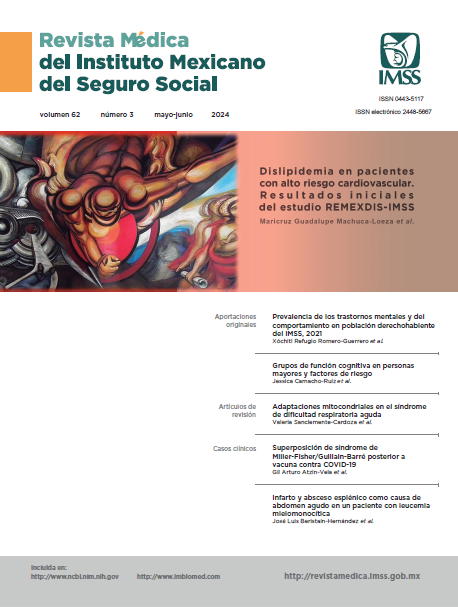Hypopigmented mycosis fungoide. Case report
Main Article Content
Keywords
Cutaneous, T-Cell, Lymphoma, Hypopigmented Mycosis Fungoides, Mycosis Fungoides
Abstract
Background: Hypopigmented mycosis fungoide (HMF) is a rare variant of cutaneous T-cell lymphoma of unknown pathogenesis. It is the most common cutaneous lymphoma in childhood. It is characterized by hypopigmented macules in non-photoexposed areas, generally asymptomatic. The diagnosis is confirmed with histopathological study and immunohistochemistry. Treatment will depend on the clinical stage, with topical therapies being the first-line treatment.
Clinic case: 69-year-old female, with no significant personal pathological history. She was treated for dermatosis of 7 years of evolution, spread to the 4 segments with affected body surface of 35% that respected palms and soles, characterized by polymorphic hypochromic macules of 1 to 10 cm in diameter that converge to form larger lesions, and some post-inflammatory hyperchromic macules, accompanied by itching. The histopathological study reported data compatible with mycosis fungoides and immunohistochemistry with positivity for CD3, CD4, CD5 and CD8. It was diagnosed stage IB HMF. It was administered treatment based on prednisone and phototherapy with a good response.
Conclusions: This case makes possible an outlook of the demographic data of HMF, and it allows this entity to be taken into consideration for possible differential diagnoses that are not contemplated due to the limited dissemination of knowledge about this disease. It is important to emphasize the knowledge of HMF since early diagnosis and timely treatment will improve the prognosis in our patients and prevent them from being treated incorrectly.
References
Luo Y, Liu Z, Liu J, et al. Mycosis Fungoides and Variants of Mycosis Fungoides: A Retrospective Study of 93 Patients in a Chinese Population at a Single Center. Ann Dermatol. 2020;32(1):14-20. doi: 10.5021/ad.2020.32.1.14.
Willemze R, Cerroni L, Kempf W, et al. The 2018 update of the WHO-EORTC classification for primary cutaneous lymphomas. Blood. 2019;133(16):1703-14. Disponible en: http://bloodjournal.org/content/133/16/1703.
Kim JC, Kim YC. Hypopigmented Mycosis Fungoides Mimicking Vitiligo. Am J Dermatopathol. 2021;43(3):213-6. doi: 10.1097/DAD.0000000000001750.
Amorim GM, Niemeyer-Corbellini JP, Quintella DC, et al. Hypopigmented mycosis fungoides: a 20-case retrospective series. Int J Dermatol. 2018;57(3):306-12. doi: 10.1111/ijd.13855.
Yang MY, Jin H, You HS, et al. Hypopigmented Mycosis Fungoides Treated with 308 nm Excimer Laser. Ann Dermatol. 2018;30(1):93-5. doi: 10.5021/ad.2018.30.1.93.
Martínez Villarreal A, Gantchev J, Lagacé F, et al. Hypopigmented Mycosis Fungoides: Loss of Pigmentation Reflects Antitumor Immune Response in Young Patients. Cancers (Basel). 2020;12(8):2007. doi: 10.3390/cancers12082007.
Ghazawi FM, Alghazawi N, Le M, et al. Environmental and Other Extrinsic Risk Factors Contributing to the Pathogenesis of Cutaneous T Cell Lymphoma (CTCL). Front Oncol. 2019;9:300. doi: 10.3389/fonc.2019.00300.
Bergallo M, Daprà V, Fava P, et al. DNA from Human Polyomaviruses, MWPyV, HPyV6, HPyV7, HPyV9 and HPyV12 in Cutaneous T-cell Lymphomas. Anticancer Res. 2018;38(7):4111-4. doi: 10.21873/anticanres.12701.
Liu H, Wang L, Lin Y, et al. The Differential Diagnosis of Hypopigmented Mycosis Fungoides and Vitiligo With Reflectance Confocal Microscopy: A Preliminary Study. Front Med (Lausanne). 2021;7:609404.doi: 10.3389/fmed.2020.609404.
Peña-Romero AG, Montes de Oca G, Fierro-Arias L, et al. Micosis fungoide hipopigmentada: diferencias clínico-histopatológicas con respecto a la micosis fungoide en placas. Dermatol Rev Mex. 2016;60(5):387-96.
Chen Y, Xu J, Qiu L, et al. Hypopigmented Mycosis Fungoides: A Clinical and Histopathology Analysis in 9 Children. Am J Dermatopathol. 2021;43(4):259-65. doi: 10.1097/DAD.0000000000001723.
Bisherwal K, Singal A, Pandhi D, et al. Hypopigmented Mycosis Fungoides: Clinical, Histological, and Immunohistochemical Remission Induced by Narrow-band Ultraviolet B. Indian J Dermatol. 2017;62(2):203-6. doi: 10.4103/ijd.IJD_365_16.
Muñoz-González H, Molina-Ruiz AM, Requena L. Clinicopathologic Variants of Mycosis Fungoides. Variantes clínico-patológicas de micosis fungoide. Actas Dermosifiliogr. 2017;108(3):192-208. doi: 10.1016/j.ad.2016.08.009.
Trautinger F, Eder J, Assaf C, et al. European Organisation for Research and Treatment of Cancer consensus recommendations for the treatment of mycosis fungoides/Sézary syndrome - Update 2017. Eur J Cancer. 2017;77:57-74. doi: 10.1016/j.ejca.2017.02.027.
Lovgren ML, Scarisbrick JJ. Update on skin directed therapies in mycosis fungoides. Chin Clin Oncol. 2019;8(1):7. doi: 10.21037/cco.2018.11.03.
Jayasinghe DR, Dissanayake K, de Silva MVC. Comparison between the histopathological and immunophenotypical features of hypopigmented and nonhypopigmented mycosis fungoides: A retrospective study. J Cutan Pathol. 2021;48(4):486-94. doi: 10.1111/cup.13882.
Shi HZ, Jiang YQ, Xu XL, et al. Hypopigmented Mycosis Fungoides: A Clinicopathological Review of 32 Patients. Clin Cosmet Investig Dermatol. 2022;15:1259-64. doi: 10.2147/CCID.S370741.
Domínguez-Gómez MA, Reyes-Salcedo CA, Morales-Sánchez MA, et al. Clinical variants of mycosis fungoides in a cohort. Variedades clínicas de micosis fungoide en una cohorte. Gac Med Mex. 2021;157(1):41-6. doi: 10.24875/GMM.20000052.
Domínguez-Gómez MA, Baldassarri-Ortego LF, Morales-Sánchez MA. Hypopigmented mycosis fungoides: A 48-case retrospective series. Australas J Dermatol. 2021;62(3):e419-20. doi: 10.1111/ajd.13565.
Barron CR, Smoller BR. Evaluation of Melanocyte Loss in Mycosis Fungoides Using SOX10 Immunohistochemistry. Dermatopathology (Basel). 2021;8(3):277-84. doi: 10.3390/dermatopathology8030034.
Landgrave-Gómez I, Ruiz-Arriaga LF, Toussaint-Caire S, et al. Epidemiological, clinical, histological, and immunohistochemical study on hypopigmented epitheliotropic T-cell dyscrasia and hypopigmented mycosis fungoides. Int J Dermatol. 2020;59(1):52-9. doi: 10.1111/ijd.14501.
Rodney IJ, Kindred C, Angra K, et al. Hypopigmented mycosis fungoides: a retrospective clinicohistopathologic study. J Eur Acad Dermatol Venereol. 2017;31(5):808-14. doi: 10.1111/jdv.13843.


